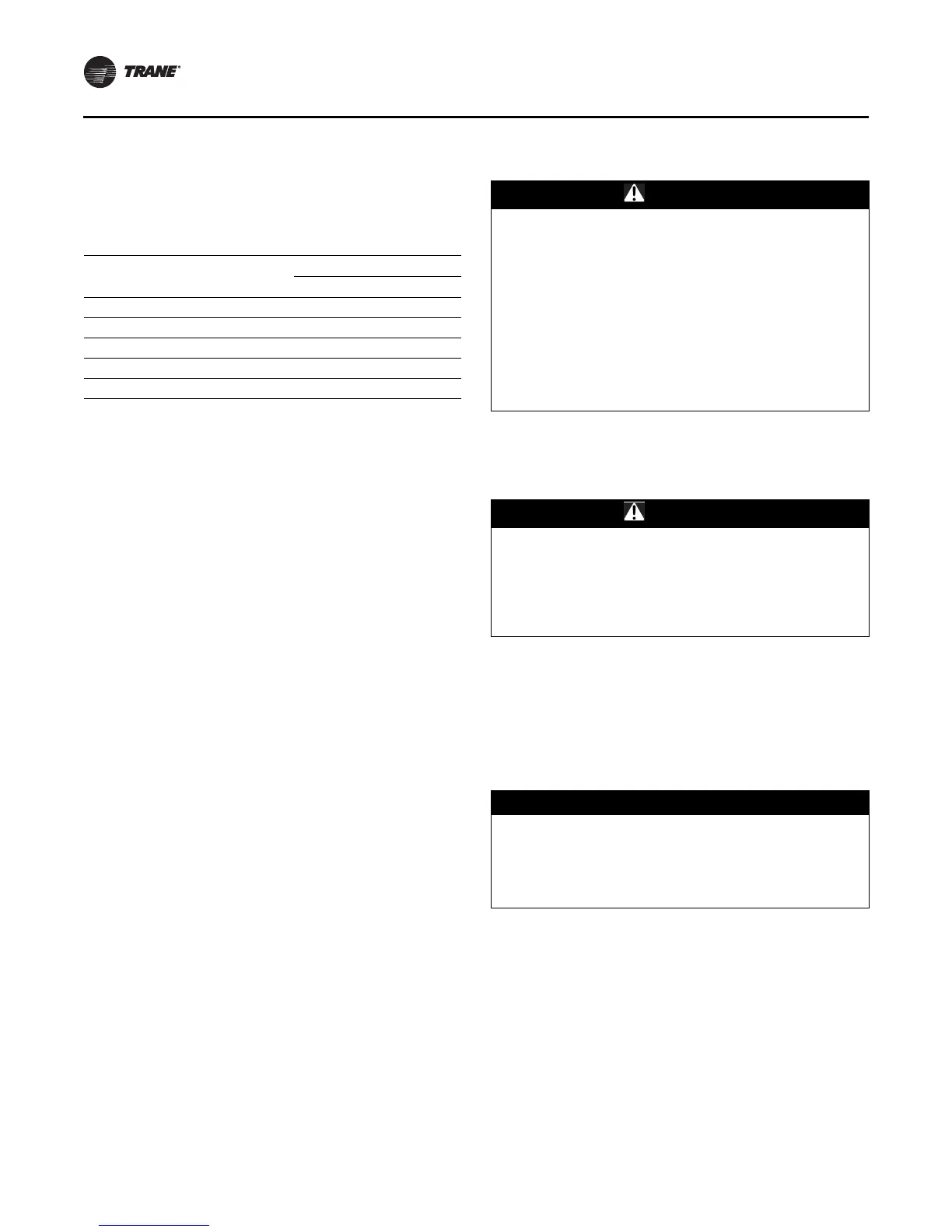Unit Piping
26 CG-SVX038A-EN
• Double risers are generally unnecessary. The scroll
compressors in Trane units unload to the extent that a
single, properly sized riser can transport oil at any load
condition.
• Riser traps are also unnecessary. Avoid using riser
traps. If the discharge riser is sized to maintain the
proper refrigerant velocity, adding a trap will only
increase the pressure drop.
Reliability determines the success of a split air-
conditioning system. Intercon
necting refrigerant lines
play an instrumental role in that success. It’s up to us to
ensure that our system design practices evolve with
equipment technologies.
This can be summarized as five fundamental “rules”:
1. Choose the right system (i.e., don’t specify split-
system equipment when a packaged chiller is best
suited for the job).
2. Size the interconnecting lines to av
oid the use of traps
and double risers.
3. Slope the liquid lines tow
ard the evaporator.
4. Minimize the length of the interconnecting tubing.
5. Keep the system clean.
Initial Leak Test
As shipped, Trane compressor-chillers contain a holding
charge of nitrogen only. Before connecting refrigerant
piping, momentarily crack open a Schraeder valve on the
liquid line to insure that the unit is still pressurized. If no
gas escapes thru the valve, leak test the unit to determine
the source of the refrigerant leak prior to installation and
repair any leaks located.
Refrigerant Piping Sizes
Refer to the Trane guide TRG-TRC006-EN and/or ASHRAE
publications to determine piping selection information.
Refrigerant pipe sizes selected must be within the velocity
and pressure drop limitations required for proper system
operations. It is essential that refrigerant piping be
properly sized and applied since these factors have a
significant effect on system performance and reliability.
Final Leak Test
Once refrigerant piping is completed, thoroughly test the
system for leaks.
System Evacuation
For field evacuation after leak checking, use a vacuum
pump capable of pulling a vacuum of 100 microns or less.
Follow the pump manufacturer’s instructions for proper
use of the pump. Insure that all sections of the system are
properly evacuated before proceeding.
Refrigerant Charging
Once the system is properly installed, leak tested and
evacuated, refrigerant charging can begin. Liquid
refrigerant must be charged into each circuit through the
liquid line access with the compressor(s) off.
Charge refrigerant into the system by weight. Use an
accurate scale or charging cylinder to determine the exact
charge entering the system. Failure to charge the system
accurately can lead to under or over-charging and result in
unreliable operation.
If system pressure equalize before the full charge enters
the system, close the charging port and proceed to start-up
procedure.
Table 10. Minimum discharge-line velocities for oil
entrainment
Nom. Pipe Size, in. Riser
Refrigerant Velocity, fpm
Horizontal
7/8 375 285
1-1/8 430 325
1-3/8 480 360
1-5/8 520 390
2-1/8 600 450
WARNING
Hazard of Explosion!
Failure to follow instructions below could result in
death or serious injury or equipment or property-only
damage. Use only dry nitrogen with a pressure
regulator for pressurizing unit. Do not use acetylene,
oxygen or compressed air or mixtures containing them
for pressure testing. Do not use mixtures of a hydrogen
containing refrigerant and air above atmospheric
pressure for pressure testing as they may become
flammable and could result in an explosion.
Refrigerant, when used as a trace gas should only be
mixed with dry nitrogen for pressurizing units.
WARNING
Risk of Internal Arc Flash!
Failure to follow instructions could result in death,
serious injury and compressor damage. Do not use a
megohmmeter or apply power to compressor windings
under vacuum as it could result in an arc flash inside
the compressor.
NOTICE:
Equipment Damage!
To prevent damage to the evaporator and condenser,
never charge liquid refrigerant into either of these
vessels without adequate flow to prevent the
temperature/pressure relationship to fall below 35°F.

